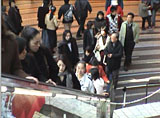|
In his series of “Musicinema,” Yasuno derives a kind of verbal music from assorted images of public space. A chorus of similar male voices is heard describing, in a stream-of-consciousness fashion, what is currently visible on screen. Their voices verbally translate the visible into reams of language that ebb and flow in a half-conscious ramble. As Yasuno writes, “A human scans the world, turning it into language. Giving voice to this language, rhythm emerges, and with it, music.”
Yasuno was born in 1979 in Tokyo, and has been interested in music since his teens. He graduated from Tokyo Music University, and went on to do graduate work at the Institute of Advanced Media Arts and Sciences. In 2006 he began the performance group “Method Machine.” Exhibitions include Kyoto Biennial (2003), Japan Media Arts Festival (2009), Echigo-Tsumari Art Triennale (2009), and International Festival of Arts and Media Yokohama (2009).
From the artist's blog:

Of the questions often asked about musicinema, one of the main things people ask me is 'where did the name come from?'
Early afternoon one day, I was on a cigarette break from my part-time job.
In front of a supermarket doing a bustling business just next to the train station.
People zipping past in front of my eyes.
Streams of middle-aged women on bicycles, their baskets filled up with groceries.
[...]
The street would empty out for a moment, then once again people would start going by.
This time it was a wave of people coming out of the station, probably because a train had just arrived.
As I was absent-mindedly watching this scene, I suddenly noticed that I was transforming the landscape in front of my eyes into language. Or to be more precise, I was transforming it into language "limited by the extent of my vocabulary." The landscape in front of my eyes was not a still photograph, but something that continued changing unevenly with the passage of time. As I mulled over the flow of language unfolding in front of my eyes, somehow it seemed - to me at least - that a kind of order was emerging. I began wanting some way to take this system of language appearing before my eyes and give it a structure, to make it some kind of concrete object. I set up a camera to record the way this scene changed moment to moment and "fix it in place." Then I looked back at the footage and listened for the language that could be heard (in the imagination) within it. I spoke these words, and this became the soundtrack. As sounds organized along a time axis are usually called a composition, I felt that a work developed this way could be thought of as composed music. Fortunately, thanks to developments in technology, nowadays even someone like me who has never held a camera before can figure out how to handle one, and even editing is fairly simple. I began filming with a second-hand video camera, editing with software that came with my computer. This was the beginning of "musicinema."
At the same time, "musicinema" was for me an attempt to respond to a particular issue. Naming this a 'music film' reversed the order of the more common expression 'film music.' At the time, I was fed up with hearing even non-film music trying to sound like it was background music for a film (that is, music that can be ignored as music, and serve as background for visuals). Music that isn't film music but tries to be, to give the impression that it could be. Not just music that seems to have a story like a film, but also music that gives off an abstract image of the kind that could be expressed in the itunes visualizer (an awful invention if there ever was one!). I felt like musicians - including myself - were in danger of being swallowed up by the strong imaginative powers of the visual. I am not saying that music isn't supposed to create an image. Music is an art form that renders the unseen world visible. Like listening to music and falling into a trance. But if this trance could be expressed just as well through visuals, then there is no longer a need for music. I think of music precisely as something that transcends what can be expressed through visual imagery. This is especially true of the new types of works coming out of the field often labeled "contemporary music." With "musicinema," I was attempting to fight this battle against images from the side of music, an eye for an eye, a tooth for a tooth. By doing this, I hoped to save at least one person from falling under the spell of the visual. Thus began "musicinema," my unilateral one-man holy war on behalf of music.
|
 |

© Taro Yasuno
|